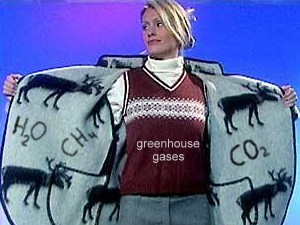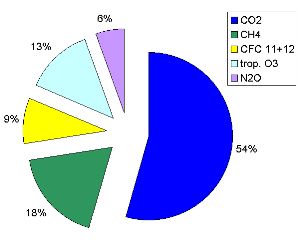 > ENC Master > Climate Encyclopaedia > Lower Atmosphere > basics > 2. Greenhouse, light & biosphere > - Greenhouse gases
> ENC Master > Climate Encyclopaedia > Lower Atmosphere > basics > 2. Greenhouse, light & biosphere > - Greenhouse gases
 |
|
|
|
Lower AtmosphereBasics!significant changes made! |
Greenhouse gases and effectThe greenhouse effect is very important for life on Earth. If there were no greenhouse gases in the air, the average temperature at the Earth surface would be roughly 30 degrees lower than the 15°C we have now in global average.
|
|
We see, that we need a natural greenhouse effect like a pullover in winter. However, if the pullover is too thick, we begin to sweat. What man does, is, to make an natural and necessary effect stronger and stronger and therefore an additional warming of the Earth occurs, which has not been the case during the last thousands of years in such an extreme manner. Therefore we are worrying about global warming and the greenhouse effect is often regarded as something bad. But it is not the natural greenhouse effect, which is bad. It is only this additional greenhouse effect caused by humen, which causes all the trouble.
|
|
Greenhouse gases do the same with the heat radiation of the Earth than a pullover does with our body in winter. They hold back the warmth and cause a warm layer around the Earth surface.
|
 |
|
|
2. Can you explain the image in your own words? Afterwards you may check and move your mouse over the text, which is written in white between the arrows: |
 |
|
|
Explain also here:
|
|
In some scientific publications the contribution to the Earth's warming is called 'radiative forcing'. It is measured in the unit Watt per square meter W/m2. Since the industrial times began around the year 1750 until now (data from year 2000) the concentrations of greenhouse gases increased a lot due to human activity. The numbers on the right say, how much the 'radiative forcing' increased due to this additional greenhouse gases in the air. The pie chart shows the relative contribution of each of the gases.
|
Radiative forcing of the additional greenhouse gases (1750 - 2000) in W/m2 1.46 CO2 (carbon dioxide) Data source: IPCC TAR 2001 |
|
Related pages: You will learn more about radiation, greenhouse gases and the energy equilibrium of the Earth in
|
About this page:Author: Dr. Elmar Uherek - Max Planck Institute for Chemistry, Mainz/Germany
|


